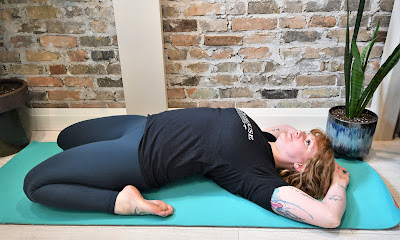 Mental Health is something that affects every single one of us regardless of culture, race, income bracket, gender, ages and educational backgrounds.
Mental Health is something that affects every single one of us regardless of culture, race, income bracket, gender, ages and educational backgrounds.
Mental Health is defined as a person's condition with regard to their psychological and emotional well-being. Investing in positive mental health and resiliency building activities helps to maintain our wellbeing.
With 1 in 5 Canadians experiencing mental illness in their lifetimes. Even more shocking is that over 60% of these people do not access treatment largely from complications related to stigma.
Slowly the conversation around Mental Health is changing. As a Massage Therapist, many of my clients come to see me as part of their mental health support system. I see a wide spectrum of clients from those actively seeking support for Anxiety management to those battling burnout and others who are looking for some time to relax and recharge.
Today we are going to look at how Massage Therapy can help to support positive mental health.
Stress Reduction
Reduces symptoms of Anxiety and Depression
Engages Parasympathetic Nervous system ( Rest & Digest)
Balances Hormones
Reduces Muscle tension and Pain
Supports Proper Breathing
Supports the Immune System
Supports the Circulatory System
Reduces Blood Pressure

Many of Massage Therapies benefits comes from its effect on the nervous system. Massage Therapy gets many of its health benefits from its soothing effect on our Sympathetic nervous system commonly responsible for our fight or flight reactions. As the body decreases the effects of stress responses we enter a state of relaxation. The relaxation response is the result of the body supporting the Parasympathetic nervous system which is primarily responsible for immune function, digestion and internal repair. It is necessary to spend time actively relaxing, known as active rest, and engaging your relaxation response to maintain mental and physical health.
Massage therapy is able to promote relaxation through a calm environment and a treatment tailored to increase relaxation and comfort. Several studies indicate the benefit of hands-on therapies to help induce a state of relaxation. Therapeutic touch can increase an individual's awareness of their body. As a result Massage therapy can be used to reduce muscle tension and pain, which in turn decreases stress stimuli within the body further supporting relaxation. For many clients, Massage Therapy is an opportunity to dissipate the tension patterns in the body that can be a result of stress.
If you are looking for a way to support your body during times of stress consider scheduling a regular massage. Talk to your practitioner next time you are in the clinic, we can help suggest treatment options and tailor your home care to your specific needs. In my practice, I have many clients who see me purely for mental wellness. Some of these clients and I work directly on counteracting the effects of anxiety other clients focus more on relaxation and having time for active rest.
Several other modalities including chiropractic, osteopathic care and acupuncture are also effective ways to support the parasympathetic nervous system and reduce muscle tension are available at the clinic. Each individual will have a different preference of modalities but it is important to find one that helps you feel comfortable and relaxed.
 As a Mental Health Advocate, I am involved in the Region of Waterloo's Ways to Wellbeing program to help support positive mental health in our greater community. Resources for this program are available within the clinic for free. To get yours contact me directly or speak to your Coach House practitioner.
As a Mental Health Advocate, I am involved in the Region of Waterloo's Ways to Wellbeing program to help support positive mental health in our greater community. Resources for this program are available within the clinic for free. To get yours contact me directly or speak to your Coach House practitioner.Interested in learning more? I provide public and corporate health lectures. For more information contact me.
Megan Prenty RMT, YT
megan@thecoachhousetc.ca
FB & Instagram
Be sure to follow The Coach House on Facebook and Instagram to keep in touch and get notifications of new blog posts.
Disclaimer: The information contained in these topics is not intended nor implied to be a substitute for professional medical advice, it is provided for general educational purposes only. This information shouldn’t take the place of seeing your primary care provider for individualized health recommendations. Hand on physical therapies have an important role in the management of mental health, however, they are no substitute for professional mental health specific support.
Be sure to follow The Coach House on Facebook and Instagram to keep in touch and get notifications of new blog posts.
Disclaimer: The information contained in these topics is not intended nor implied to be a substitute for professional medical advice, it is provided for general educational purposes only. This information shouldn’t take the place of seeing your primary care provider for individualized health recommendations. Hand on physical therapies have an important role in the management of mental health, however, they are no substitute for professional mental health specific support.
Related Posts you may be interested in:
Further Research- Studies on Mental Health and Massage Therapy:
Brief report: A pilot study evaluating mindfulness-based stress reduction and massage for the management of chronic pain
The American Massage Therapy Association, various research has shown the benefits of using massage to help treat mental health conditions in different types of situations.
















